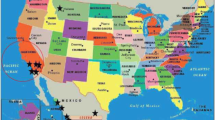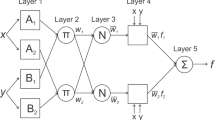Abstract
The earthquake is known to be an unpredictable geophysical phenomenon. Only few seismic indicators and assumptions of earthquakes can be predicted with probable certainty. This study attempts to analyze the earthquakes over the Indo-Himalayan Border region including Bhutan, Bangladesh, Nepal, China and India during the period from 1995 to 2015. Bangladesh, Bhutan and China borders experience fewer earthquakes than Nepal and India border regions. However, Indo-China rim has inconsistency and vast range in its magnitude. Bangladesh though is a small country with respect to others, but it experiences earthquakes comparable to Bhutan. Nepal experiences highest number of earthquakes. In the last 20 years around 800 records have been observed with moment magnitude > 4.0 Richter scale, while very few records (around 10–12) have been observed for large earthquakes having moment magnitude > 6.0 Richter scale over the region. In this study adaptive neuro-fuzzy inference system has been implemented to assess the predictability of seismic moment associated with large earthquakes having the moment magnitude between 6.0 and 8.0 Richter scales using different combination of epochs, technique and membership functions. The Gaussian membership function with hybrid technique and 40 epochs is observed to be the reasonable model on the basis of the selected spatial and temporal scale. The forecast error in terms of root-mean-square error with the stop** criterion 0.001 has been observed to be 0.006 in case of large earthquakes (> 6.5 Richter scale), that is, forecast accuracy of 99.4%. The model bias of 0.6% may be due to inadequate number of large earthquakes having moment magnitude > 6.5 Richter scale over the region.












Similar content being viewed by others
References
Aki K (1981) A probabilistic synthesis of precursory phenomena. In: Simpson DW, Richards PG (eds) Earthquake prediction. American Geophysical Union, Washington. doi:10.1029/ME004p0566
Bonissone PP (1997) Soft computing: the convergence of emerging reasoning technologies. Soft Comput 1:6–18
Chaudhuri S (2006) A hybrid model to estimate the depth of potential convective instability during severe thunderstorms. Soft Comput 10:643. doi:10.1007/s00500-005-0532-6
Chaudhuri S (2007) Chaotic graph theory approach for identification of convective available potential energy (CAPE) patterns required for the genesis of severe thunderstorms. Adv Complex Syst 10:413. doi:10.1142/S0219525907001215
Chaudhuri S (2008) Preferred type of cloud in the genesis of severe thunderstorms—a soft computing approach. Atmos Res 88:149–156
Chaudhuri S (2010) Convective energies in forecasting severe thunderstorms with one hidden layer neural net and variable learning rate back propagation algorithm. Asia Pacific J Atmos Sci 46:173. doi:10.1007/s13143-010-0016-1
Chaudhuri S, Midey A (2011) Adaptive neuro-fuzzy inference system to forecast peak gust speed during thunderstorms. Meteorol Atmos Phys 114:139. doi:10.1007/s00703-011-0158-4
Chaudhuri S, Midey A, Goswami S, Banerjee S (2012) Appraisal of the prevalence of severe tropical storms over Indian Ocean by screening the features of tropical depressions. Nat Hazards 61:745. doi:10.1007/s11069-011-0068-2
Chen CH, Wang JP, Wu YM, Chan CH, Chang CH (2013) A study of earthquake inter-occurrence times distribution models in Taiwan. Nat Hazards 69:1335–1350
Gupta D, Shahani DT (2014) Probabilistic neural network algorithm for using radon emanations as an earthquake precursor. J Geol Soc India 84:155–158
Jang JS (1993) ANFIS: adaptive-network-based fuzzy inference system. IEEE Trans Syst Man Cybern 23:665–685
Kagan YY, Knopoff L (1987) Statistical short-term earthquake prediction. Science 236:1563–1567
Karimi I, Hullermeier E, Meskouris K (2007) A fuzzy-probabilistic earthquake risk assessment system. Soft Comput 11:229. doi:10.1007/s00500-006-0063-9
Lakshmi SS, Tiwari R (2009) Model dissection from earthquake time series: a comparative analysis using modern non-linear forecasting and artificial neural network approaches. Comput Geosci 35:191–204
Lay T, Kanamori H (1981) An asperity model of large earthquake sequences. In: Simpson DW, Richards PG (eds) Earthquake prediction. American Geophysical Union, Washington. doi:10.1029/ME004p0579
Leach R, Dowla F (1996) Earthquake early warning system using real-time signal processing. Neural networks for signal processing. In: Proceedings of the 1996 IEEE Signal Processing Society Workshop, pp 463–472. doi:10.1109/NNSP.1996.548376
Mirrashid M (2014) Earthquake magnitude prediction by adaptive neuro-fuzzy inference system (ANFIS) based on fuzzy C-means algorithm. Nat Hazards 74:1577–1593
Mirrashid M, Givehchi M, Miri M, Madandoust R (2016) Performance investigation of neuro-fuzzy system for earthquake prediction. Asian J Civ Eng (BHRC) 17:213–223
Mittal H, Wu YM, Chen DY, Chao WA (2016) Stochastic finite modeling of ground motion for March 5 2012, Mw 4.6 earthquake and scenario greater magnitude earthquake in the proximity of Delhi. Nat Hazards 82:1123–1146
Mogi K (1981) Earthquake prediction program in Japan. In: Simpson DW, Richards PG (eds) Earthquake prediction. American Geophysical Union, Washington. doi:10.1029/ME004p0635
Mukhopadhyay B, Dasgupta S, Fnais M, Mukhopadhyay M (2011) Modelling the pore fluid diffusion process in aftershock initiation for 2004 Sumatra earthquake: implications for marine geohazard estimation in the Andaman region. Nat Hazards 57:39–49
Rikitake T (1968) Earthquake prediction. Earth Sci Rev 4:245–282
Sandeep AJ, Kamal PK, Kumari P (2014) Modeling of strong motion generation area of the Uttarkashi earthquake using modified semiempirical approach. Nat Hazards 73:2041–2066
Steckler M et al (2016) Locked and loading megathrust linked to active subduction beneath the Indo-Burman Ranges. Nat Geosci. doi:10.1038/ngeo2760
Sykes LR (1971) Aftershock zones of great earthquakes, seismicity gaps, and earthquake prediction for Alaska and the Aleutians. J Geophys Res 76:8021–8041
Varotsos P, Lazaridou M (1991) Latest aspects of earthquake prediction in Greece based on seismic electric signals. Tectonophysics 188:321–347
Wakita H, Nakamura Y, Notsu K, Noguchi M, Asada T (1980) Radon anomaly: a possible precursor of the 1978 Izu-Oshima-kinkai earthquake. Science 207:882–883
Wakita H, Igarashi G, Notsu K (1991) An anomalous radon decrease in groundwater prior to an M6.0 earthquake: a possible precursor? Geophys Res Lett 18:629–632
Wang W, Wu GF, Huang BS, Zhuan KY, Zhou PL, Jiang CX, Zhou YH (1997) The FAM (fuzzy associative memory) neural network model and its application in earthquake prediction. Acta Seismol Sin 10:321–328
Wei H (2007) Earthquake prediction model based on matlab toolbox. Seismol Res Northeast China 23:64–68
Whitcomb JH, Garmany JD, Anderson DL (1973) Earthquake prediction: variation of seismic velocities before the San Francisco earthquake (Report). Science 180:632–635
**e J, Qiu J, Li W, Wang J (2011) The application of neural network model in earthquake prediction in East China. Adv Intell Soft Comput 106:79–84
Yang J, Chen J, Liu H, Zheng J (2014) Comparison of two large earthquakes in China: the 2008 Sichuan Wenchuan earthquake and the 2013 Sichuan Lushan earthquake. Nat Hazards 73:1127–1136
Acknowledgements
The corresponding author acknowledges the Ministry of Science and Technology, Government of India, for providing the opportunity to participate in Climate Change Programme through weather and climate extremes.
Author information
Authors and Affiliations
Corresponding author
Rights and permissions
About this article
Cite this article
Chaudhuri, S., Chowdhury, A.R. & Das, P. Implementation of Sugeno: ANFIS for forecasting the seismic moment of large earthquakes over Indo-Himalayan region. Nat Hazards 90, 391–405 (2018). https://doi.org/10.1007/s11069-017-3049-2
Received:
Accepted:
Published:
Issue Date:
DOI: https://doi.org/10.1007/s11069-017-3049-2




